Opinion

USA – -(AmmoLand.com)- Sometimes you have to wonder when you run across an old gun, one that has seen better days, if it is worth saving. We have all seen the old guns in the shop; many relegated to the term “wall hanger” long past its prime and best left to be seen and remembered.
I remember the old double-barrel shotgun that used to hang over my grandfather’s fireplace, it belonged to his grandfather and dated back to at least the 1840s. One of my cousins was the last to use it some thirty-plus years ago.
The last I remember seeing it, the stock had cracked in a couple of places, but it was still somewhat functional but was long past its time. Sometimes guns like that are best remembered fondly, like echoes from the past. I have a Sharps four barreled derringer that is no longer safe to use; it’s an earlier gun so we’re talking sometime in the 1860s for sure and it came out of Montana. Did it belong to a gambler, some dandy who didn’t have a way to carry a larger gun, or did it one time belong to a Civil War soldier who carried it hidden during his days in uniform? Its origins are lost to time now.
I’ve been in enough gun shops here and there and been there when some old guns have been brought in, usually by family members who have inherited them or found them and want to sell them. Sadly, it’s becoming more and more common that many who get these guns have no interest in keeping them. I recall one couple who inherited their grandfather’s guns. Some were very nice, and the family only wanted to get what they could out of them and weren’t even interested in what the guns were worth, the family just wanted them gone. One remarked they wished they had just inherited money. I hope when I am gone my family treats my guns with a lot better respect than those ingrates did.
Over the last couple of years, I have picked up a few older guns, some dating well over a hundred years old. One is a very nice Winchester 1885 Low Wall in .32-20 that was made in 1889, another a nice Marlin 94 in the same caliber made sometime around 1916. One of the most recent was a Model 94 Winchester made in the late 1930s that came out of Alaska where it spent most of its life.
These were all nice guns in excellent condition, so it would figure the last gun I acquired is something on the opposite end of that scale.
I was at a local gun shop recently and spotted the familiar shape of a long-barreled Winchester, and was handed something that looked at first as if it had spent its time outside after being left there. It was a Model 1894 Winchester in .38-55 WIN and an early gun at that, made in 1895. It has a 26-inch octagon barrel, a very heavily pitted barrel on the outside, but shockingly, the barrel on the inside is excellent, the rifling is crisp and no pitting at all. The action on the gun works perfectly, with the chamber being clean, no pitting there, but the outside of the receiver is another matter. It too is fairly worn, the finish long gone, even the lever has some pitting on it. I got the gun cheap enough, paying only $300 for it. Of course, it was still even money if that was going to be wasted cash or a sound investment.
When I showed pictures of the gun online, I was met with mixed reactions of ridicule and envy. Some said that the old Winchester must be a disaster and didn’t believe that the gun was even salvageable, others said to shoot it as it is and to heck with refinishing it. I checked around to see what it would cost to restore the gun, and I was told of course that it could be done, but it was extremely expensive and would cost two to three times what it’s worth in mint condition. The other issue is the wood the gun came with, wasn’t the original wood, and I am not even sure where it came from. The forearm is anyone’s guess, and the buttstock appear to have come from a Winchester Model 64, but since that buttstock has a pistol grip and the 1894 has a straight lever, the pistol grip was trimmed down and smoothed out so everything would work. I’m not sure if it came from another gun, the buttstock has no holes at all for a buttplate.
So, the question came down to did I restore the gun back to its original condition? Or did I try and fix it to where I could at least fire it, not knowing if simply shooting it affect the integrity of the barrel considering the pitting on the outside of the barrel, or did I just put it up on display where it could be seen?

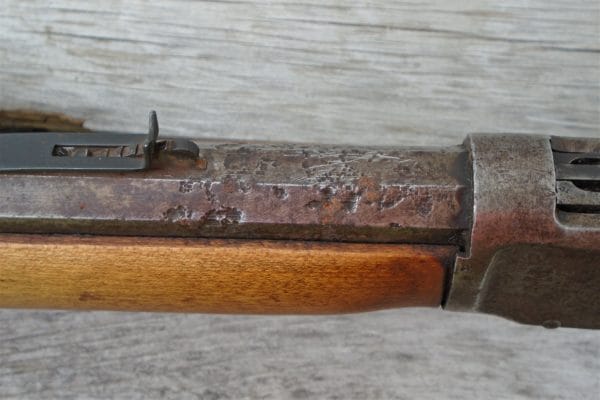
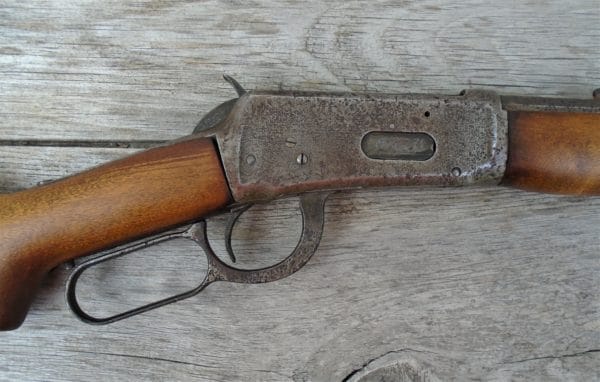
So, I had my project. I have tried to get in touch with the man who sold the old Winchester to the gun shop, at best I found out he’s well into his seventies, and until recently himself used the rifle for hunting. According to what I was told, it has accounted for a great many whitetail deer in the Adirondack Mountains. I have sent for a letter on the gun from Cody, Wyoming and am still waiting to hear back on the origin on the Winchester.
The first thing I did was start looking for parts, a correct buttstock here, a forearm there. I refinished them as both as close as I good get them to where they should look, but the forearm was much paler than the buttstock, and it remains so. I didn’t want the wood to look perfect anyway as it certainly wouldn’t blend in very well.
After doing a lot of research and deciding against having the pitting filled in with solder since I didn’t want any heat near the barrel, I decided to fill in the worst spots with JB Weld. Thinking the JB could be removed if the next owner wanted to go full-monty on a future restoration. Again, not trying to make the gun look perfect, but to smooth out the surface of the barrel.
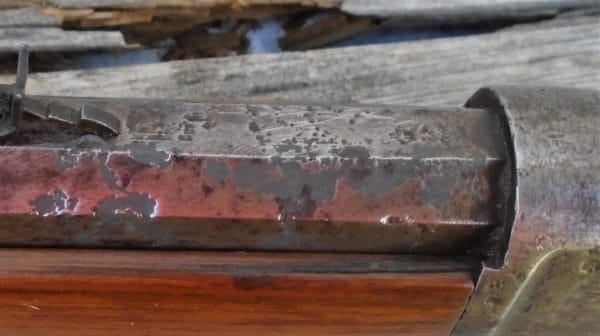
The rear sight that came on the gun wasn’t correct, was beat up and missing pieces so I decided to add a Lyman tang sight I had lying around. The rear sight I cut down and rounded off and made a blank for the dovetail out of it.
I went through the gun back to front, checking all the springs, making sure everything was at least sound. I cleaned up the gun as much as I could, but in the end, the real proof was to shoot the gun.

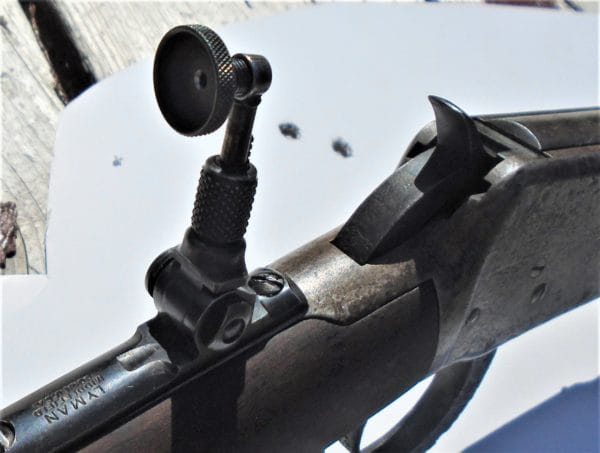
I went to the range with a box of factory .38-55 Winchester ammunition. With its 255 grain round that measured at .375” it was going to be interesting since these early Winchester 1894’s tend to have oversize bores. When I slugged this gun, that proved to be true since this one came out at .378”, a size I have heard many come in at.
I have to admit that when I fired the first shot, my face was nowhere near the buttstock when I did.
The gun went off without a hitch, no issues at all. So, then I decided to try my best to see what type of accuracy I could squeeze out of the old 1894, and I was shocked once I got the sights on target to see that this gun printed a three-shot group at 25 yards just under an inch. All the rounds fired just fine; the action had a little hiccupping when feeding at first, but I quickly found a small burr on one of the cartridge guides. I smoothed that out and put a little oil on them and then everything went just fine.
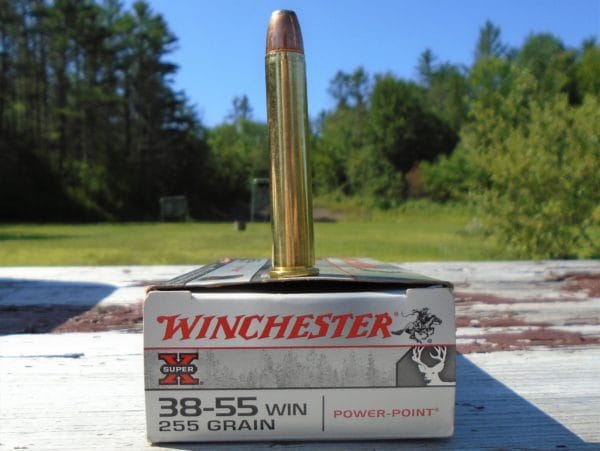

I then took a bison target out to the 50-yard line and put another three-shot group out there, this time a little wider, about two inches, but the gun not only impressed me, but it also amazed me at the accuracy I was getting out of it. I decided not to push the old gun anymore, but I can tell you that it was very pleasing to get this horse out of the corral once more.
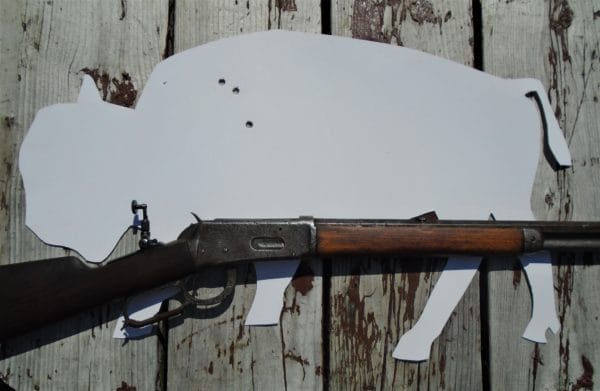
I asked the owners of the gun shop how many people looked at the old Winchester and passed it by, more than a few I had been told. They were even skeptical it could ever be shot again. I know one of them said it would make a great wall hanger. Maybe someday it will, but it won’t be anytime soon if I have anything to say about it.
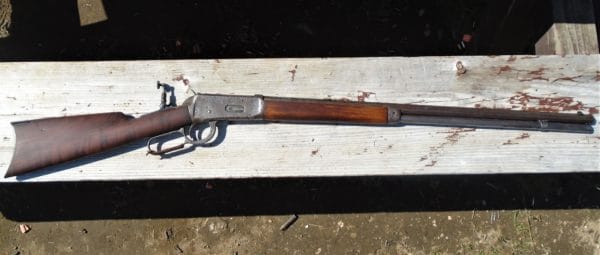
I wish I could say we could save all these old guns could be saved. There’s more than a few of them out there gathering dust, and some should just be allowed to enjoy the retirement they’ve earned, but now and again, you come across a gun like this old Winchester that has one foot in the grave and the other on a banana peel. It just takes a little tug to bring it back from what some think is certain death to give it another chance at life. And if you get them cheap enough what do we have to lose?

About David LaPell
David LaPell has been a Corrections Officer with the local Sheriff’s Department for thirteen years. A collector of antique and vintage firearms for over twenty years and an avid hunter. David has been writing articles about firearms, hunting, and western history for ten years. In addition to having a passion for vintage guns, he is also a fan of old trucks and has written articles on those as well.
